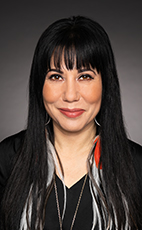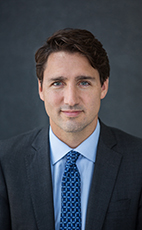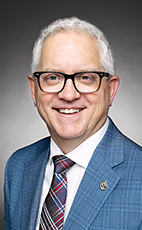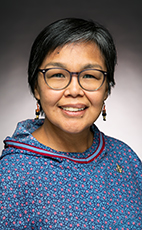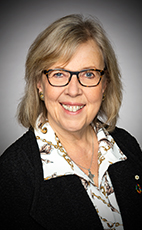44th Parl. 1st Sess.
May 4, 2022 02:00PM
- May/4/22 2:17:53 p.m.
- Watch
Mr. Speaker, tomorrow is the National Day of Awareness for Missing and Murdered Indigenous Women, Girls and Two-Spirited Peoples. I wish to lift up all organizations, families and survivors of violence who have led the way in advocating for justice, and all of those who are working to put an end to this crisis of violence reported in the National Inquiry into Missing and Murdered Indigenous Women and Girls almost three years ago.
In spite of the alarming findings in the report, we have witnessed little action from the federal government, including in this year's budget where there is zero new budgetary allocation to address this ongoing genocide. This is unacceptable, especially in light of the alarming increase in gender-based violence that has occurred as a result of the pandemic.
With communities, families and survivors of violence, we stand in solidarity, and I commit to not allowing this genocide to fall by the wayside. I call on all members of Parliament to join me and respond to this crisis with the urgency it deserves.
177 words
All Topics
- Hear!
- Rabble!
- add
- star_border
- share
- May/4/22 2:57:16 p.m.
- Watch
Mr. Speaker, I want to begin by thanking the member for Brampton South for her hard work.
Our government is committed to working alongside indigenous partners and survivors to end violence against indigenous women, girls and 2SLGBTQQI+ people in Canada and the tragedy of MMIWG. That is why we invested over $100 million in budget 2021 to re-establish and revitalize indigenous cultural spaces, which responds to call for justice 2.3. This work has begun, for example, in the Skeetchestn Indian Band in B.C. with funding for the construction of a traditional pit home and museum facility that the community has long advocated for, as well—
109 words
- Hear!
- Rabble!
- add
- star_border
- share
- May/4/22 3:18:01 p.m.
- Watch
Mr. Speaker, the National Inquiry into Missing and Murdered Indigenous Women and Girls released its findings in June 2019.
The Prime Minister accepted these findings, yet three years later there has been little action and no additional money to actually implement the findings.
Grieving families are waiting. When will the government commit to real action on implementing the report and the findings?
62 words
- Hear!
- Rabble!
- add
- star_border
- share
- May/4/22 3:18:33 p.m.
- Watch
Mr. Speaker, our hearts continue to be with survivors and families of missing and murdered indigenous women and girls, two-spirit and 2SLGBTQIA+ people.
The Minister of Crown-Indigenous Relations will be leading the take-note debate on this topic tonight, because addressing this ongoing violence requires living up to our goals as a country and all the calls for justice.
In June 2021, partners from across the country came together and released the national action plan, including the federal pathway to finally end this ongoing tragedy. When the member opposite talks about doing nothing, let me highlight that this will all be supported by budget 2021's $2.2-billion investment in concrete measures to help keep people safe.
120 words
- Hear!
- Rabble!
- add
- star_border
- share
- May/4/22 7:24:49 p.m.
- Watch
moved:
That this committee take note of missing and murdered Indigenous women and girls.
He said: Madam Chair, kwe, kwe. Unusakut. Tansi. Hello. Bonjour.
I want to start by acknowledging that Canada's Parliament is located on the traditional and unceded territory of the Algonquin Anishinabe people.
I will be splitting my time with the member for Nunavut.
The tragedy of missing and murdered indigenous women and girls is ongoing. Tomorrow, on May 5, thousands of red dresses will be hung in city squares, on porches, in trees, on fences and in gardens across Canada. These red dresses are a reminder of the pain and loss felt by families, survivors and communities of missing and murdered first nations, Inuit and Métis women, girls, two-spirit and gender-diverse people.
Last June, together with federal, provincial, territorial, municipal and indigenous partners, we launched the missing and murdered indigenous women, girls and 2SLGBTQQIA+ people national action plan. This includes the Government of Canada's contribution: the federal pathway to address missing and murdered 2SLGBTQQIA+ people.
Is the federal pathway perfect? No, it is not. It is an evergreen document that is intended to evolve, constantly adapt and be trauma-informed, with input foremost from survivors and their families.
Naturally, it will take a government-wide and Canada-wide approach, involving more than 25 federal departments and agencies, the provinces and territories, indigenous organizations and other partners throughout the country, to put this plan into action and bring an end to this tragedy.
This is a national responsibility. The calls for justice in the final report urge governments and society in all its forms to act, and we must fulfill that obligation.
Indigenous groups have long expressed the need for safe, culturally relevant spaces as a key component to move forward on self-determination. The Truth and Reconciliation Commission called for this, as did the National Inquiry into Missing and Murdered Indigenous Women and Girls in section 2.3 of the final report. We are listening and will continue to listen. We are taking action and will continue to take action.
As part of the federal pathway, budget 2021 announced a total of $2.2 billion over five years, notably with $160.9 million ongoing, to end violence against indigenous women, girls and 2SLGBTQQIA+. However, I would like to focus on a particular section of that funding: the $108.8 million over two years that was allocated specifically for the cultural spaces and indigenous communities program that I mentioned just now in French, which responds directly to call to justice 2.3. The program offers opportunities for indigenous women, girls and gender-diverse people to access culture and language to help them strengthen their identities, which in turn can enhance their safety and security.
Last month, I had the opportunity to visit several communities to see the impacts of these projects, which they had been fighting for, in some cases, for over a couple of decades.
In the territory of Kahnawà:ke, for example, we announced $16 million in funding for the construction of a new building to house Kanien'kehá:ka Onkwawén:na Raotitióhkwa, a language and cultural centre with space for the Turtle Island Theatre Company.
These new buildings will help them preserve and enrich their culture, as well as empower new generations of Mohawk learners in a safe and accessible space so they can learn about their community from their peers.
Across the country, in 108 Mile Ranch, British Columbia, we announced a $4-million project. We are funding the construction of a cultural centre in northern Secwépemc territory. Five communities have come together and have been fighting for 17 years to obtain it.
These will be key moments. When the projects are built, people will have safe spaces in which to learn their language and culture, and can expose others to them.
We are currently reviewing other proposals, and there will be additional announcements in due course.
Clearly, as we are making progress, much more needs to be done to answer all of these calls and fully implement the federal pathway. Quite frankly, nobody in Canada should be satisfied until all indigenous women and girls and 2SLGBTQQIA+ people are safe.
Meegwetch.
713 words
All Topics
- Hear!
- Rabble!
- add
- star_border
- share
- May/4/22 7:29:28 p.m.
- Watch
Madam Chair, I want to thank the minister for his comments today. I know he is sincere.
In September 2016, the National Inquiry into Missing and Murdered Indigenous Women and Girls began. In June 2019, the final report was completed. In December 2019, the Minister of Crown-Indigenous Relations at the time promised to table the national action plan by June 2020. After an extra year, the plan was actually tabled. In that plan, there were seven immediate steps for governments and indigenous organizations to focus on in the immediate 12 months. We are now at the 11-month point.
I am asking if the minister can tell us how many and specifically which of these steps have already been completed, how many are in progress and how many have yet to be started.
134 words
All Topics
- Hear!
- Rabble!
- add
- star_border
- share
- May/4/22 7:32:15 p.m.
- Watch
Madam Chair, I want to acknowledge that the riding the member opposite represents, as she knows well, is part of the epicentre of the tragedy. Her advocacy is key in making sure that this tragedy ceases to continue and in fact ends. We all know, sadly, that it will not end tomorrow. However, investments that we have made, particularly in her riding for the Ka Ni Kanichihk, for example, very recently, thanks to the member opposite's advocacy, will be key in continuing to accompany survivors and people who are suffering violence.
What we have seen in the last two years is an escalation of that violence, due in part to the pandemic. It is something we have to be very clear-eyed about and acknowledge. The work that has been done over the last six years by this government, whether it is the passage of UNDRIP, the passage of the Indigenous Languages Act or the passage of the child and family services inherent rights in Bill C-92, is part of this immense puzzle that, without being resolved, is continuing the tragedy.
There are steps and goals over the next three years that we will have to be very bloody-minded in achieving. Clearly we will need to accelerate the path on this, and that is something I have undertaken to do.
223 words
All Topics
- Hear!
- Rabble!
- add
- star_border
- share
- May/4/22 7:34:58 p.m.
- Watch
Qujannamiik, Uqaqtittiji.
I want to thank the Minister of Crown-Indigenous Relations for sharing his time with me. I am dismayed that I have to stand today and that we still need to debate sustained funding and commitments after so much work has already been completed to ensure that all Canadians understand the injustice experienced by Inuit, first nations and Métis families.
On June 3, it will be three years since the National Inquiry into Missing and Murdered Indigenous Women and Girls and 2SLGBTQQIA published “Reclaiming Power and Place”. The inquiry made 231 calls for justice. The report concluded that the acts of violence against indigenous women, girls and gender-diverse people in Canada constitute genocide. The calls for justice stated:
Indigenous women, girls, and 2SLGBTQQIA people in Canada have been the targets of violence for far too long. This truth is undeniable. The fact that this National Inquiry is happening now doesn’t mean that Indigenous Peoples waited this long to speak up; it means it took this long for Canada to listen.
In the 2022 budget, there were no new funds to stop the genocide. The events leading up to this debate show that Canada still does not know how to listen. With great leadership by the member for Winnipeg Centre and the New Democrats, we have advocated for solidarity and support for victims and their families. Not including new funds for MMIWG must only be allowed to stop when all indigenous families have found justice.
We have to be inspired by the stories and testimony of the courageous people who started this important work. Included in the engagement during the inquiry were over 2,380 people, 468 family members and survivors of violence, 15 community gatherings with almost 750 people sharing statements in gatherings, and 84 expert witnesses. We must not shut down the momentum that was started.
I asked a question on April 8 during a debate: Why are no new funds committed in budget 2022? The response was to indicate how much was promised in the past.
I now turn to an Inuk woman who went missing. Mary Papatsie was the youngest of eight siblings raised in Pangnirtung, Nunavut. She was a hockey and volleyball coach who loved to fish. Mary later moved to Ottawa's Hintonburg neighbourhood but spent most of her time in the Vanier neighbourhood.
Mary Papatsie was 39 years old and a mother of 10 when she was last seen on the afternoon of April 27, 2017. She was last seen east of Ottawa's downtown centre in the area of Montreal Road and Marier Avenue. Mary is missed. Mary is still missing. When Mary first disappeared, there was very little support to make sure there was a proper search for her. I want to thank Billie Jo for sharing her story.
I will complete my statement by amplifying the work of YWCA Agvik Nunavut, which provides a women's shelter, a transition house and other programs. Agvik has organized a red dress march in Iqaluit for tomorrow, starting at 2:00 p.m., starting from the Elders Qammaq and going to the Nunavut Court of Justice.
531 words
All Topics
- Hear!
- Rabble!
- add
- star_border
- share
- May/4/22 7:39:04 p.m.
- Watch
Mr. Chair, first we need to acknowledge that no single budgetary cycle can address this tragedy adequately. There will have to be sustained investments. We also have to acknowledge that in every budget, survivors and families should recognize the investments as responding specifically to this tragedy. If there is a criticism to be levelled on the budget, it is that while there are investments from MMIWG across the government, the language does not fit the investments.
I read a statistic that should have been top of mind, and it should be a good reminder to all Canadians. In Nunavut, for the period of 2001-14, the rate of murdered women was 12.4 women per population of 100,000. In the non-indigenous population it is 0.71, so it is roughly 20 times worse.
We know that housing is a real challenge. It has been for some time for many reasons. The current budget does have $4 billion plus $2 billion for housing specifically to deal with the indigenous housing crisis.
Perhaps the member opposite could speak to the crisis in her community, as it has a direct impact on women in Nunavut.
194 words
All Topics
- Hear!
- Rabble!
- add
- star_border
- share
- May/4/22 7:42:09 p.m.
- Watch
Mr. Chair, I want to thank my colleague from Nunavut for the work we do together on the INAN committee.
The Coalition on Missing and Murdered Indigenous Women and Girls in B.C., the Ontario Native Women's Association and Quebec Native Women are groups that asked to be included in the process in developing the national action plan but were excluded.
Does the member believe that the exclusion of the voices of the grassroots in the development of the national action plan will impact the long-term success of that action plan?
93 words
All Topics
- Hear!
- Rabble!
- add
- star_border
- share
- May/4/22 7:44:41 p.m.
- Watch
Mr. Chair, I will be splitting my time with the member for Haliburton—Kawartha Lakes—Brock.
I rise tonight to take part in this debate with a heavy heart. Unfortunately, the issue of missing and murdered indigenous women and girls is too prevalent in my northern Saskatchewan riding, and one does not have to look very far to find heartbreaking stories.
Just last September, during the election campaign, the communities of Meadow Lake and the neighbouring Flying Dust First Nation were rattled to the core when a local schoolteacher was shot and killed by her estranged husband. Charlene was 34 years old and the mother of two children.
It is a tragedy when this happens, period, but for indigenous people across the country, it happens at alarming rates, and we all need to be part of changing that. The fact is that indigenous people are overrepresented as victims of violent crime. More specifically, they are over twice as likely as non-indigenous people to experience spousal violence. When looking at the most severe form of intimate partner violence, homicide, a similar pattern emerges. While about 5% of the population is indigenous, one-quarter of intimate partner homicide victims between 2014 and 2019 were indigenous.
I share the story of Charlene because I believe it is imperative that we, as legislators, remember that these are not just statistics but real people with families who are impacted.
I want to focus, in what little time I have, on several positive initiatives that I believe are raising awareness and respectfully remembering missing and murdered indigenous women and girls.
Tomorrow, we will mark Red Dress Day across Canada. It was Métis artist Jaime Black who helped inspire the red dress movement. Her REDress art installation evolved into the annual Red Dress Day and sparked a grassroots movement across North America. Every year, people hang red dresses in private and public spaces to remember and to stand in solidarity with family members and loved ones.
Walking With Our Sisters is another community-based art installation that honours missing and murdered indigenous women and children. Beginning in 2012, people were asked to design and create moccasin tops for their missing and murdered loved ones. Men, women and children from all backgrounds and all parts of Canada sent in 1,600 of these vamps, more than doubling the initial goal of 600. In 2019, this art installation travelled to more than 25 locations across North America.
Another initiative is the faceless doll project. Created in 2012 by the Native Women's Association of Canada, the faceless doll project encourages people to make dolls to represent missing and murdered women and those affected by violence. As I shared earlier, often we can look at the enormity of the problem here in Canada and forget that behind each number and each statistic is a life, and this project reminds us of just that.
Next week, on May 12, Canadians from coast to coast will mark Moose Hide Campaign Day. The Moose Hide Campaign is an indigenous-led grassroots movement that encourages men and boys to stand up against violence toward women and children. With that goal, their challenge to men and boys across Canada is to stand with women and children and speak out against violence toward them; support each other as men and hold each other accountable; teach boys the true meaning of love and respect and how to be healthy role models; heal ourselves as men and support our brothers on their healing journey.
I would like to end by referencing a blog post written by Heather Exner-Pirot and Angela Pratt. Exner-Pirot is a senior consultant with Morris Interactive, and Pratt is the director of economic and community development at the Federation of Sovereign Indigenous Nations in Saskatchewan. The main theme is providing a better future for indigenous women, which I believe is a very important aspect that needs to be addressed in tonight's debate.
They discuss the link between income and safety and quote a study outlining how the rates of domestic violence are impacted by women's income. They write, “Besides exposing Indigenous women to violence, the lack of a decent, stable income and the resulting poverty has many other negative impacts.” Specifically referencing Saskatchewan and accessing good-paying jobs, they continue, “Closing the wage gap for Indigenous women means making sure they can access the best paying jobs in the province. And for Saskatchewan, that means the natural resources sector”. They end the post with a challenge: “Creating a better future for Indigenous women in Saskatchewan, and for the province as a whole, means removing the many barriers that have prevented Indigenous women from financial independence.”
Indigenous women and girls have been the target of violence for far too long. Canada, as a country, cannot fulfill its full potential until this crisis is solved.
823 words
All Topics
- Hear!
- Rabble!
- add
- star_border
- share
- May/4/22 7:51:21 p.m.
- Watch
Mr. Chair, I could not idly sit by when I heard the previous speaker suggest that it is only through their employment that people find self-worth.
I will give the hon. member the opportunity, given the context of the debate that is before us today, to rise in this House and suggest ways in which he would be willing to support the basic dignity around housing, income supports and health care that go beyond settler-colonial resource extraction, which, quite frankly, is often at the heart of this continued perpetuation of genocide against indigenous women and girls.
98 words
All Topics
- Hear!
- Rabble!
- add
- star_border
- share
- May/4/22 7:52:15 p.m.
- Watch
Mr. Chair, I may fundamentally disagree with the member on some issues, but if he is interested, I have some information that was provided to me recently from someone I am going to call “Estella”.
Estella is an indigenous woman who grew up in northern Alberta, a first nations woman who ran away from an abusive home many times. She felt compelled to write this op-ed, she says in this document. She says, “Today I am a heavy equipment operator at an oil sands mine in northern Alberta. I make a good wage, more than twice what I made in the city”. I am going to leap ahead to where she talks about the opportunity to have income and have a good job. She says, “To get training, to get a good paying job, and to support their family and feel proud about it. The resource sector provides that opportunity to tens of thousands of us. I wish it was more. Instead of pitting us against the resource sector, the government should be ensuring that more of those jobs are available to people like me.”
I remind members that Estella is a member of Cowessess First Nation and a board member from the Indigenous Resource Network.
213 words
All Topics
- Hear!
- Rabble!
- add
- star_border
- share
- May/4/22 7:54:03 p.m.
- Watch
Mr. Chair, education is absolutely fundamental to the success of many on their journey out of poverty, out of some of the social challenges that we find in a riding like mine in northern Saskatchewan. I would remind the member that my riding has the second-largest indigenous population in the country. I have been working with people in northern Saskatchewan to make sure that they get access to a quality education. To upgrade that quality of education, we must work in conjunction with the federal department that is responsible for education on first nations and with the provincial folks who are responsible for the education off the first nations. We have to have a coordinated effort to educate young people, enhance their opportunity and give them that chance of success.
131 words
All Topics
- Hear!
- Rabble!
- add
- star_border
- share
- May/4/22 7:54:57 p.m.
- Watch
Mr. Chair, I rise today in the House to speak to a matter that evokes strong emotions on all sides, a matter that speaks to the tragedy of racism and discrimination and a matter that requires continued vigilance to overcome. Of course, I speak of the horrors of the murdered and missing indigenous women and girls in this country.
Before I get into my speech, I would like to thank my colleague, the member for Desnethé—Missinippi—Churchill River, for sharing his time with me this evening.
The stats speak for themselves. Indigenous women and girls in Canada are disproportionately affected by all forms of violence. Although indigenous women make up just 4% of Canada's female population, 16% of all women murdered in Canada between 1980 and 2012 were indigenous. The 2019 general social survey on victimization, along with Stats Canada, has indicated that indigenous women were more likely to experience intimate partner violence than non-indigenous women.
Furthermore, during our study on sex trafficking of indigenous people last June, experts told us that 52% of human trafficking victims are indigenous and that the average age of exploitation of an indigenous girl is, shockingly, just 12 years.
Although the indigenous population up to the age of 14 makes up 7.7% of all Canadian children, they represent 52.2% of the children in care. We also know that studies have highlighted that having a child in the welfare system is the most common feature among women and girls who enter prostitution.
Most alarmingly, the statistics may be even more tragic, as experts told the committee that one of the biggest problems is how difficult it is to accurately track how many victims there are of human trafficking and sex trafficking, as well as to accurately track the correct number of missing and murdered indigenous women and girls. Without real effort from the government to ensure that a robust framework is in place, with adequate resources that are made available for indigenous data collection, in consultation with indigenous experts and organizations, the true story of their reality may never be truly known.
The final report of the National Inquiry into Missing and Murdered Indigenous Women and Girls made 231 calls for justice in 2019. It took two years of waiting for the government's action plan on missing and murdered indigenous women and girls, a plan that many involved called toxic, flawed and unsafe. The government has failed to address one of the core elements in the inquiry: that any plan has an obligation to the victims, their families and all indigenous women and girls, to ensure their voices are reflected so that indigenous women today and future generations of women and girls can live their lives free of violence.
Unfortunately, the government's most recent budget implementation act also fails in this regard. With respect to investments in the budget to address the safety of indigenous women and girls, the Native Women's Association of Canada described its concerns: “We're very concerned that on the surface of this reading of the budget announcement, we don't see where the investment is going to be and we have a very serious concern about that.”
The track record of the government has become abundantly clear. Instead of tackling the systemic inequalities, violence and unsafe conditions for indigenous women and girls in this country, it simply throws money and hopes those issues go away. This will do nothing to empower indigenous women and girls. Rather, it will simply grow bureaucracies here in Ottawa. To be fair, past governments must share the blame in continuing this broken “Ottawa knows best” system, a system that has a profoundly lasting and damaging impact on indigenous culture, heritage and language. For true reconciliation to begin, this paternalistic approach to indigenous people and issues must end.
We must not sideline off-reserve and non-status communities either. Women and girls tend to gravitate to urban centres to escape violence, and that creates greater problems, because they cannot access employment, adequate housing or even shelter, and they become victims of a cycle that has been perpetuated by a lack of resources and inadequate supports for them.
In closing, indigenous women and girls need a safe, culturally supportive environment in which they are free from violence, sexual trafficking and exploitation. If we are honest about reconciliation, the current and succeeding governments have an obligation to honour indigenous perspectives when addressing underlying factors that create the unsafe conditions for women and girls, such as precarious housing, poor living conditions, high rates of unemployment, unstable employment, low working wages and the lack of access to social and economic resources.
I look forward to the questions ahead.
793 words
All Topics
- Hear!
- Rabble!
- add
- star_border
- share
- May/4/22 8:00:02 p.m.
- Watch
Mr. Chair, my colleague touched on a subject that is very important to me. In fact, at yesterday's general meeting of the All-Party Parliamentary Group to End Modern Slavery and Human Trafficking, I was re-elected vice-chair.
We have studied this issue extensively. My colleague mentioned that 54% of human trafficking victims are indigenous women. That is huge. He also said that before concrete solutions to help these women can be proposed, a lot more data and studies are needed.
During the pandemic, some of these numbers were lost. The pandemic really complicated the research being done to get a more accurate picture of human trafficking and its impact on indigenous women. I would ask my colleague to comment on that.
124 words
All Topics
- Hear!
- Rabble!
- add
- star_border
- share
- May/4/22 8:00:52 p.m.
- Watch
Mr. Chair, I thank my friend for Shefford for that question. She is absolutely right. Even in committee, the experts said that the numbers were not as accurate as they probably could be, because the correct information was not there and the data was not there.
We heard a number of recommendations from committee, all the way from changing how indigenous police services are able to operate, act and still have the same power as off-reserve police services, to how they can use their officers who know the community, know the people in the community and use traditional methods to deal with certain situations. That was one in a very long series of recommendations that I hope the government takes into account. I hope it actually acts on some of them, because I think we can have real change and help a lot of people.
146 words
All Topics
- Hear!
- Rabble!
- add
- star_border
- share
- May/4/22 8:01:42 p.m.
- Watch
Uqaqtittiji.
I would like to thank the member for his intervention. That was great. I am glad that he outlined some of the factors that lead to the incidents that we see all too often. I wanted to ask the member what he thinks about all those indicators impacting indigenous people's and indigenous women's perspectives on what they need to rely on, including the perceived need for resource industries and gaining employment in those kinds of sectors, because those sectors are the places where most of the violence is being caused.
Could the member share what his thoughts are on that?
103 words
All Topics
- Hear!
- Rabble!
- add
- star_border
- share
- May/4/22 8:02:27 p.m.
- Watch
Mr. Chair, I appreciate the question from my friend for Nunavut. She is a great advocate for her territory in committee. I enjoy working with her. In fact, I have learned a lot from her and respect everything she has to say. I truly enjoy my time with her. I see the member for Winnipeg Centre right in front of her, who also spent time on committee. I learned a lot from her as well.
In terms of the resource part, we heard that as the economy recovers from COVID, indigenous people have a very large, young population. I think if we want to actually reach full potential, we need to have strategies so they at least feel included. I think they would, and I think that is a shortfall of governments past. It has been a big failure all the way through.
On resources, I was at a conference not too long ago in Vancouver. A lot of the conversation was on an estimated $2-trillion worth of minerals in first nations communities, and they think that number is low. That could provide an economic boost to a number of communities, especially in the north and remote areas. That is just one part.
There is a not-for-profit in my riding that does coding for students in Nunavut. There is a whole series of opportunities. If we stop the top-down approach and actually listen to people on the ground, we can make some changes here instead of the Ottawa-knows-best approach.
255 words
All Topics
- Hear!
- Rabble!
- add
- star_border
- share
- May/4/22 8:04:11 p.m.
- Watch
Mr. Chair, I noted the member's conversation about what police services should do. It has not come up yet in the take-note debate. I want to ask about the risk to indigenous women and girls who are murdered by police.
Does he have any comment on the problem of wellness checks and how we might be able to remedy that problem?
63 words
All Topics
- Hear!
- Rabble!
- add
- star_border
- share
- menumenu
- notificationsnotifications
- home
- mailmail
- searchsearch



